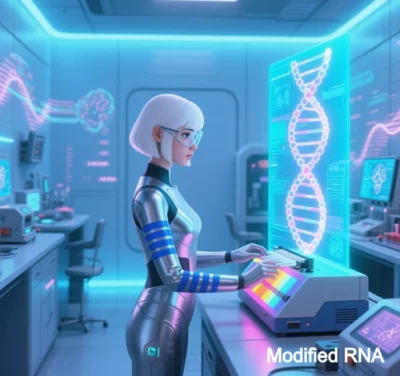
Applications of Modified RNA in Gene Therapy
Modified RNA technology has significantly enhanced the precision, safety, and applicability of gene therapy through chemical or sequence optimization. Below are representative case studies and mechanistic insights into its therapeutic applications:
I. Gene Correction and Replacement
1. Cystic Fibrosis
- Technology: Chemically modified CFTR mRNA (with 1-methylpseudouridine, m1Ψ) delivered to lungs via lipid nanoparticles (LNPs).
- Mechanism: The mRNA encodes functional CFTR protein, restoring chloride ion channel activity. In murine models, a single dose improved lung function for over 7 days.
- Advantages: Avoids genomic integration risks associated with viral vectors and enables controlled expression duration.
2. β-Thalassemia
- Technology: Cas9 mRNA combined with single-stranded DNA templates, delivered to hematopoietic stem cells via electroporation.
- Mechanism: Precisely repairs β-globin gene mutations (e.g., IVS2-654 C→T), restoring hemoglobin synthesis. Editing efficiency reached 85%, outperforming traditional nucleases.
- Innovation: Chemical modifications (e.g., phosphorothioate backbone) enhance mRNA stability and reduce immunogenicity.
II. Immune Modulation and Vaccines
1. COVID-19 mRNA Vaccines
- Technology: Spike protein-encoding mRNA modified with m1Ψ and encapsulated in LNPs.
- Mechanism: mRNA is translated into antigens post-cellular uptake, activating T- and B-cell immune responses. Clinical trials showed >90% efficacy with fewer side effects than conventional vaccines.
- Breakthrough: m1Ψ modification evades innate immune recognition (e.g., TLR7/8), minimizing inflammatory responses.
2. Personalized Cancer Vaccines
- Technology: Modified mRNA encoding tumor neoantigens combined with PD-1 inhibitors.
- Case Study: BNT111 (melanoma vaccine) encodes 20 neoantigens, activating antigen-specific T cells. Phase II trials reported a 35% objective response rate (ORR).
- Delivery Optimization: Dendritic cell-targeted LNPs enhance antigen presentation efficiency.
III. Delivery System Innovations
1. Brain-Targeted Delivery
- Technology: LNPs fused with exosomes and FUS protein for mRNA delivery.
- Application: A single intracranial injection of HTT siRNA-modified mRNA reduced mutant protein aggregation in Huntington’s disease models, with effects lasting 4 weeks.
- Advantage: Overcomes the blood-brain barrier, achieving 5x higher delivery efficiency than conventional methods.
2. Spatiotemporal Editing
- Technology: Optogenetically controlled Cas13 mRNA system (integrated with LOV2 photosensitive protein).
- Mechanism: Blue light activates Cas13 to cleave target RNA, enabling tissue-specific gene silencing. Used for spatiotemporally controlled tumor suppression in zebrafish models.
IV. Rare and Metabolic Diseases
1. Spinal Muscular Atrophy (SMA)
- Technology: Antisense oligonucleotides (ASOs) modified with 2′-MOE to promote SMN2 exon 7 retention.
- Efficacy: FDA-approved Nusinersen (Spinraza) improved motor function scores by 51% in patients.
- Mechanism: ASOs bind SMN2 pre-mRNA, blocking inhibitory splicing factors.
2. Pyruvate Kinase Deficiency (PKD)
- Technology: TALEN mRNA edits PKLR gene in hematopoietic stem cells.
- Outcome: Preclinical models showed 80% restoration of erythrocyte pyruvate kinase activity and reduced hemolytic anemia.
V. Cellular Reprogramming and Regenerative Medicine
1. Induced Pluripotent Stem Cells (iPSCs)
- Technology: Modified mRNA (pseudouridine-incorporated) encoding KLF4, OCT4, and SOX2 reprograms fibroblasts.
- Advantages: No genomic integration risks; reprogramming efficiency reaches 0.2% (10x higher than viral vectors).
- Application: Used for autologous cardiomyocyte regeneration in myocardial infarction models.
2. Transient CRISPR/Cas9 Editing
- Technology: Co-delivery of Cas9 mRNA and sgRNA to treat Duchenne muscular dystrophy (DMD).
- Mechanism: Skips DMD exon 51, partially restoring dystrophin function. Preclinical studies showed 40% improvement in muscle strength.
VI. Future Directions and Challenges
- Multimodal Integration: Develop RNA-DNA hybrid vectors (e.g., CRISPR-Cas9 mRNA + ASOs) for combined gene editing and epigenetic regulation.
- AI-Driven Design: Tools like SpliceBERT predict optimal splicing modification sites to minimize off-target effects.
- Long-Term Delivery: Self-amplifying RNA (saRNA) extends protein expression to 28 days, suitable for chronic diseases.
Conclusion
Modified RNA, enhanced by chemical optimizations (e.g., m1Ψ, phosphorothioate) and delivery innovations (LNPs, optogenetic systems), demonstrates transformative potential in treating genetic disorders, cancers, and infectious diseases. Its core strengths—programmability, safety, and rapid adaptability—position it as a cornerstone of precision medicine. With advances in synthetic biology and AI integration, modified RNA is poised to tackle “undruggable” targets and usher in a new era of gene therapy.
Data sourced from public references. Contact: chuanchuan810@gmail.com.





